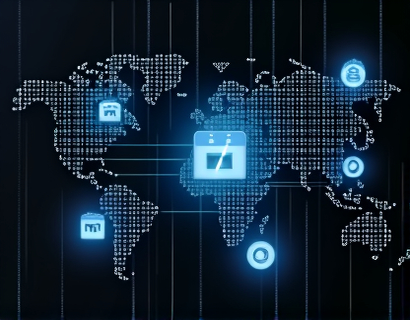Agricultural Software: Revolutionizing Farming Efficiency with Tailored Tech Solutions
In the rapidly evolving landscape of agriculture, the integration of advanced software solutions has emerged as a pivotal factor in enhancing farming efficiency and productivity. The term AgriTech encapsulates the innovative technologies and software applications designed to transform traditional farming practices into smart, data-driven operations. This article delves into the transformative impact of agricultural software, exploring how tailored tech solutions are revolutionizing the way farming professionals manage their operations, make strategic decisions, and ultimately achieve growth in a highly competitive market.
The Need for Agricultural Software
The agricultural sector faces numerous challenges, from unpredictable weather patterns and soil degradation to market fluctuations and labor shortages. These challenges necessitate a more efficient and precise approach to farming. Agricultural software addresses these issues by providing tools that streamline various aspects of farm management, from planting and harvesting to supply chain logistics. By leveraging technology, farmers can optimize resource use, reduce waste, and increase yields, thereby enhancing their overall operational efficiency.
Streamlining Farm Management Processes
One of the primary benefits of agricultural software is its ability to streamline farm management processes. Traditional methods often involve manual record-keeping and manual data entry, which are time-consuming and prone to errors. Modern software solutions automate these tasks, allowing farmers to focus on more critical aspects of their operations. For instance, farm management software can handle tasks such as field mapping, crop monitoring, and equipment maintenance, all through a user-friendly interface.
These platforms often include modules for inventory management, which helps farmers keep track of inputs like seeds, fertilizers, and pesticides. By maintaining accurate inventories, farmers can ensure they have the necessary resources when needed, reducing the risk of shortages or overstocking. Additionally, the software can generate reports and alerts, providing real-time insights into inventory levels and usage patterns, which aids in better planning and decision-making.
Enhancing Data Management
Data management is a cornerstone of modern agriculture, and agricultural software plays a crucial role in this area. The data generated from various farm operations, such as soil sensors, weather stations, and machinery, can be overwhelming to manage manually. Advanced software solutions offer robust data management capabilities, allowing farmers to collect, store, and analyze large volumes of data efficiently.
These systems often include features like data visualization, which transforms complex data into easy-to-understand graphs and charts. This visual representation helps farmers identify trends, patterns, and anomalies, enabling them to make informed decisions. For example, by analyzing soil moisture data, farmers can optimize irrigation schedules, ensuring crops receive the right amount of water at the right times. Similarly, weather data can be used to predict and prepare for adverse conditions, minimizing crop damage and loss.
Supporting Strategic Decision-Making
Strategic decision-making is essential for the success of any agricultural operation. Agricultural software provides the necessary tools and insights to support these decisions. By integrating data from multiple sources, the software can offer comprehensive analytics and predictive models. These tools help farmers forecast crop yields, optimize resource allocation, and plan for future seasons with greater accuracy.
For instance, precision agriculture software uses GPS and GIS technology to create detailed maps of fields, highlighting areas that require specific attention. This level of detail allows farmers to implement variable rate technology, applying inputs like fertilizers and pesticides only where needed. This not only reduces costs but also minimizes environmental impact. Additionally, the software can simulate different scenarios, helping farmers evaluate the potential outcomes of various strategies before implementing them.
Improving Operational Efficiency
Operational efficiency is a key factor in the success of modern farming operations. Agricultural software enhances efficiency by automating routine tasks and providing real-time monitoring capabilities. For example, automated irrigation systems can be controlled through the software, ensuring that water is used only when and where it is needed. This precision reduces water waste and ensures optimal crop growth.
Equipment management is another area where software shines. Farm machinery often operates in harsh conditions and requires regular maintenance to function optimally. The software can schedule maintenance tasks based on usage data and manufacturer recommendations, preventing breakdowns and extending the lifespan of equipment. This proactive approach to maintenance not only saves time and money but also ensures that machinery is always in top condition when needed.
Enhancing Supply Chain Management
Supply chain management is a critical component of agricultural operations, and agricultural software can significantly improve this process. From farm to table, the journey of agricultural products involves multiple stakeholders, including farmers, processors, distributors, and retailers. Software solutions can streamline this complex network by providing end-to-end visibility and coordination.
For farmers, the software can facilitate direct sales to consumers or distributors through integrated e-commerce platforms. This direct-to-consumer model can increase profit margins and reduce dependency on intermediaries. For distributors and retailers, the software can track the origin and quality of products, ensuring compliance with regulatory standards and building consumer trust. Real-time tracking and traceability features help in quickly identifying and addressing any issues in the supply chain, such as delays or quality concerns.
Fostering Sustainability and Environmental Stewardship
Sustainability is a growing concern in the agricultural sector, and agricultural software can play a vital role in promoting environmentally friendly practices. By optimizing resource use and reducing waste, these solutions contribute to more sustainable farming. For example, precision agriculture techniques enabled by software can minimize the use of chemical inputs, reducing their impact on the environment. Additionally, the software can help farmers adopt conservation practices, such as crop rotation and cover cropping, which improve soil health and biodiversity.
Carbon footprint reduction is another area where agricultural software can make a difference. By optimizing machinery usage and reducing unnecessary travel, farmers can lower their greenhouse gas emissions. Some software solutions even include carbon footprint calculators, helping farmers understand and manage their environmental impact. This data-driven approach not only benefits the environment but also aligns with growing consumer demand for sustainably produced food.
Challenges and Considerations
While the benefits of agricultural software are clear, there are several challenges and considerations that farmers and industry professionals should be aware of. One of the primary challenges is the initial cost of implementing these systems. High-quality software solutions can be expensive, and small-scale farmers may find it difficult to afford them. However, many software providers offer flexible pricing models, including subscription-based plans, to make these tools more accessible.
Another challenge is the need for technical expertise to effectively use and maintain the software. Farmers and their staff may require training to fully leverage the features and benefits of the software. This is where professional support and training services become essential. Many software providers offer comprehensive training programs and ongoing support to ensure users can maximize the potential of their investments.
Data security and privacy are also critical concerns. Agricultural software often handles sensitive information, and ensuring the protection of this data is paramount. Reputable software providers implement robust security measures, such as encryption and regular security audits, to safeguard user data. Farmers should carefully evaluate the security protocols of any software they consider implementing.
Future Trends in Agricultural Software
The future of agricultural software is exciting, with several emerging trends poised to further revolutionize the industry. One such trend is the integration of artificial intelligence (AI) and machine learning (ML) into farming operations. AI can analyze vast amounts of data to provide deeper insights and more accurate predictions. For example, AI-powered systems can identify early signs of crop diseases or pests, allowing for timely intervention and reducing the need for chemical treatments.
Another trend is the development of Internet of Things (IoT) devices specifically designed for agriculture. These devices, such as smart sensors and drones, can collect real-time data on various parameters, from soil moisture to crop health. When integrated with agricultural software, this data can be used to make informed decisions and optimize farm operations. The combination of IoT and software creates a more connected and intelligent farming ecosystem.
Blockchain technology is also gaining traction in the agricultural sector. Blockchain can enhance transparency and traceability in the supply chain, ensuring that products are authentic and meet quality standards. This technology can help build consumer trust and open up new market opportunities for farmers and producers.
Conclusion
The integration of agricultural software is transforming the farming industry, offering a range of benefits that enhance efficiency, productivity, and sustainability. From streamlining farm management processes to supporting strategic decision-making and improving supply chain management, these tailored tech solutions are empowering farming professionals to thrive in a competitive market. As technology continues to advance, the potential for further innovation in the agricultural sector is vast, promising a future where farming is more efficient, sustainable, and profitable.










































